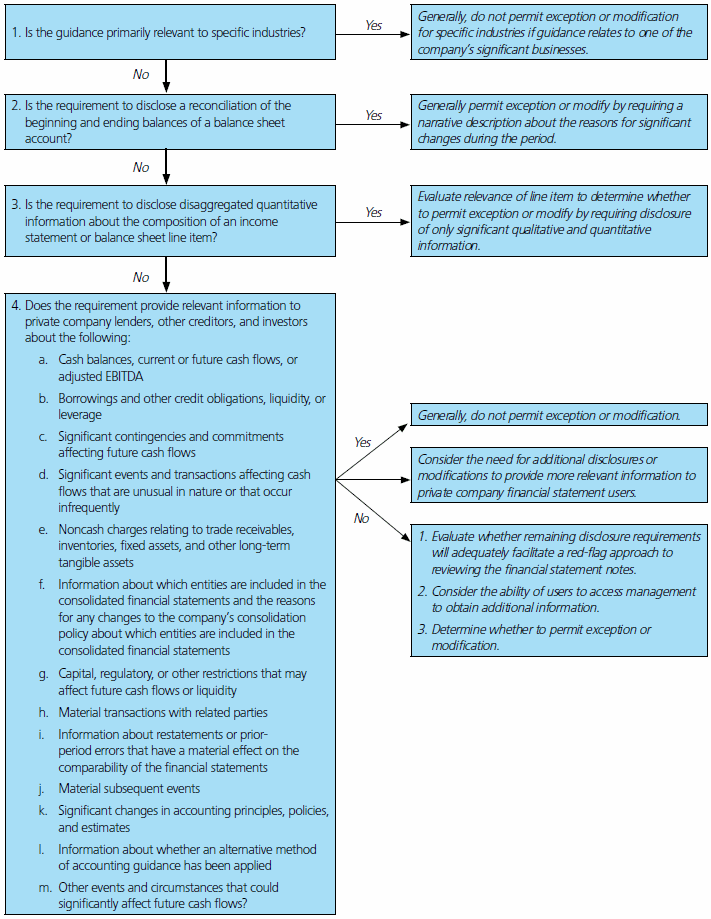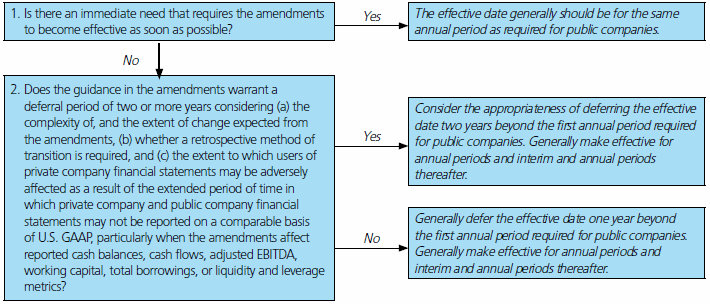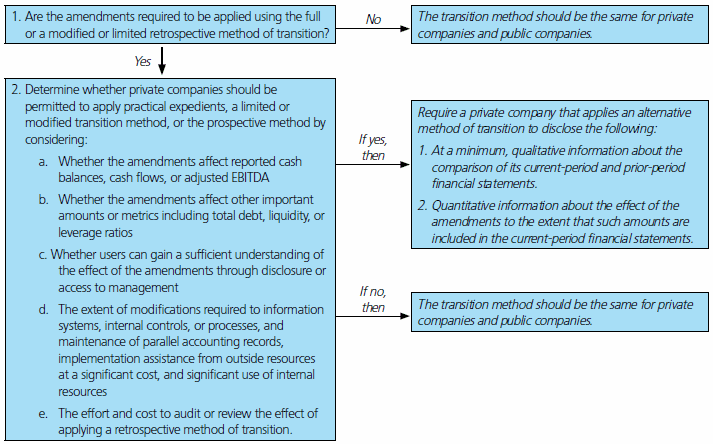by Stuart Moss and Tim Kolber, Deloitte & Touche LLP
Heads Up — FASB issues discussion paper on private-company decision-making framework

Volume 19, Issue 17
On July 31, 2012, the FASB staff released a discussion paper (DP)1 requesting comments on a proposed framework that the FASB and Private Company Council (PCC)2 would use to determine whether modifications or exceptions to existing and proposed U.S. GAAP are warranted for private companies.
The draft framework addresses the following areas in which exceptions or modifications might be considered: (1) recognition and measurement, (2) disclosure, (3) presentation, (4) effective date, and (5) transition guidance.
The FASB and PCC have not deliberated any of the information in the DP and will not begin to do so until all comments have been received.
Comments on the DP are due by October 31, 2012.
Background
Over the years, the Financial Accounting Foundation (FAF) and FASB have issued several reports, studies, and formal recommendations to address the concerns of preparers and users of private-company financial statements. One of the most notable of these publications was the January 2011 report issued by the Blue-Ribbon Panel (BRP) on Standard Setting for Private Companies. In one of its most significant proposals, the report recommended the development of a decision-making framework to identify instances in which exceptions or modifications to U.S. GAAP would be warranted for private companies. (For more information about the BRP report, see Deloitte’s January 31, 2011, Heads Up.)
Subsequently, in July 2011, the FASB conducted a comprehensive assessment examining (1) how the needs of private-company and public-company financial statement users differ and (2) the cost-benefit implications for private-company versus public-company reporting. The assessment resulted in the identification of six significant factors (detailed in the DP) distinguishing between private-company and public-company reporting considerations. To monitor this assessment and to help the Board develop its decision-making framework, the FASB formed the 10-member Private Company Resources Group. Then, in October 2011, the FAF issued a request for comment3 on its proposal to create an organization, the Private Company Standards Improvement Council, that would work toward improving the standard-setting process for private companies. (For more information, see Deloitte’s October 10, 2011, Heads Up). The end result of these efforts was the creation of the PCC in May 2012 (see the FAF’s report) and the issuance of the DP detailing the proposed framework.
See Appendix A for additional discussion of the six significant factors and their implications.
Proposed Framework
The DP proposes criteria for deciding whether modifications or exceptions to U.S. GAAP are warranted for private companies. Areas of U.S. GAAP in which exceptions or modifications might be warranted include (1) recognition and measurement, (2) disclosure, (3) presentation, (4) effective date, and (5) transition guidance.
Recognition and Measurement
The FASB and PCC will assess whether the recognition and measurement guidance for private companies should differ from that for public companies. This assessment would begin with determining “whether the recognition or measurement guidance being evaluated provides relevant information to users of private company financial statements at a reasonable cost.” The analysis would take into account a number of factors, including (1) relevance of guidance compared with typical information used by private-company financial statement users, (2) characteristics differentiating private-company and public-company financial statement users, and (3) costs and complexity associated with applying standards.
In addition, the DP highlights that in evaluating instances in which exceptions or modifications may be needed, the FASB and PCC should consider costs that financial statement users and preparers might incur when implementing the new guidance. The FASB and PCC should also consider whether users of private-company financial statements have access to management and can request additional information to supplement any disclosed information. In addition, the DP highlights that industry-specific guidance would generally not be considered under this framework because “there is a presumption that the same [unique] recognition and measurement guidance is relevant to financial statement users of both public companies and private companies operating in those industries.”
See Appendix B for the list of “relevance to users” and “cost and complexity” questions that the FASB and PCC will consider when determining whether recognition and measurement exceptions or modifications are warranted.
Disclosure
As with recognition and measurement considerations, the DP clarifies that the FASB and PCC must first analyze whether the disclosure provides relevant information to financial statement users at a reasonable cost. The DP contains a number of factors that should be considered in the determination of whether disclosure exceptions or modifications are warranted for private companies. These factors are divided into three broad categories:
- Relevance of guidance.
- Knowledge that users have about the reporting entity and about users’ ability to obtain additional information from management.
- Other factors, including (1) resource constraints of private companies and costs of preparing, auditing, and reviewing disclosure information and (2) timing of financial statement availability and the risk that disclosure may include proprietary information.
See Appendix B for a flowchart illustrating the framework for deciding whether to permit disclosure exceptions or modifications for private companies.
Presentation
The DP includes a presumption that both private and public companies would be subject to the same financial statement presentation requirements. However, the DP indicates that this presumption may be overlooked depending on factors such as (1) whether information is industry-specific, (2) whether certain exceptions are already permitted under U.S. GAAP (e.g., earnings per share), (3) whether exceptions or modifications result from other areas in the decision-making framework (e.g., recognition and measurement, disclosure), and (4) the overall effect on amounts and metrics used by typical financial statement users.
See Appendix B for a flowchart illustrating whether private companies should be provided with exceptions or modifications to presentation requirements.
Effective Dates
The DP asserts that private companies generally should be required to adopt new guidance one year after the first annual period of public-company adoption and that early adoption should be permitted. In addition, private companies should not be required to adopt new accounting standards during an interim period within the initial year of adoption. If these two provisions are finalized, private companies would have the additional time they need to appropriately implement the new guidance. However, the DP does indicate that in certain situations, the effective date for private companies might not be deferred beyond the effective date for public companies.
See Appendix B for a flowchart illustrating the decision-making framework for evaluating the effective date of new guidance for private companies.
Transition Method
The FASB and PCC should assess whether, in situations in which public entities are required to apply new guidance retrospectively, private companies should use the same retrospective transition method (i.e., full retrospective method or a modified/limited retrospective approach) as public companies. This assessment will involve consideration of potential practical expedients, including those for public companies, and of the benefits and costs related to limited or modified retrospective method alternatives. Once this assessment is complete, the FASB and PCC would consider whether the prospective, rather than the retrospective, method of transition would be more appropriate for private companies.
See Appendix B for a flowchart illustrating the decision-making framework for the transition method for private companies.
Next Steps
Comments on the DP are due by October 31, 2012. The FAF is expected to appoint new members to the PCC in the near term. After the comment period and the appointment of PCC members, the FASB and PCC plan to jointly consider the comments and finalize the private-company decision-making framework.
|
Editor’s Note: Concurrently with developing the private-company decision-making framework, the FASB has been working on a separate project to formally define the term “nonpublic entity.” That project would help clarify which entities are within the framework’s scope. The FASB intends to expose the tentative definition of nonpublic entity for public comment. The Board will discuss constituents’ feedback on the DP collaboratively with the PCC before finalizing its decisions on this definition. |
Appendix A — Differential Factors and Financial Reporting Implications —Public Versus Private Companies
The table below summarizes the six significant factors, as included in the FASB’s DP, that differentiate private-company and public-company reporting considerations as well as the implications of these factors for private-company reporting.
|
Factor |
Description |
Implications |
|
Types and Number of Financial Statement Users |
There are generally far fewer private-company users (e.g., lenders, creditors, equity investors) than public-company users (e.g., equity and debt investors, analysts). While preparers of private-company financial statements can control the distribution of the financial statements and related reports, public-company financial statements are more broadly distributed, “primarily . . . to provide information to the public capital markets.” |
Private-company financial statements should address the needs of their most typical users (i.e., lenders, creditors, and equity investors), who are generally concerned about cash, liquidity, and cash flows from operations. Because preparers control the distribution of the financial statements, they generally understand what disclosures users find relevant. This is important to assessing the effect of new accounting and disclosure guidance and its cost-benefit implications. |
|
Financial Statement User Access to Management |
Private-company financial statement users generally have greater access to management than their public-company counterparts and therefore typically have more opportunity to request additional information (e.g., amounts or disclosures included in financial statements) when needed. |
A user’s access to management may affect the benefits and costs of implementing new guidance. |
|
Investment Strategies |
The investment strategies of private companies often differ from those of public companies. Private-company equity investors will generally hold their investments longer because they are anticipating returns on their investment in the form of (1) dividends, (2) possible buyouts, (3) business combinations, or (4) initial public offerings. Public-company investors typically hold equity investments for a shorter period, since they often consider changes in share price to be the primary source of return on their investments. |
As a result of these differences in investment strategies, private-company investors generally focus more on accounting and disclosure requirements affecting cash and EBITDA and less on requirements that increase the volatility of the financial statements. |
|
Ownership and Capital Structure |
A private company’s ownership and capital funding are generally significantly different from a public company’s, since private companies focus more on (1) income taxes and estate taxes, (2) succession planning, (3) stock ownership and transfer restrictions, and (4) limiting exposure to personal liability and loss. In addition, a private company is generally structured in such a manner (e.g., S corporations, limited liability companies, sole proprietorships, trusts) that earnings are passed through to its owners and taxed at the individual owner level rather than the company level. Private companies also often have multiple entities under common control, resulting in a higher frequency of related parties, guarantees, and cross-collateral arrangements. |
An entity should consider how new guidance may affect financial statement users when determining whether a difference in recognition, measurement, disclosure, or presentation requirements is warranted. |
|
Accounting Resources |
Private companies generally have fewer and less specialized accounting personnel than public companies; thus, private companies typically focus less on monitoring changes in accounting guidance and the overall standard-setting process. Similarly, some of the accounting firms serving private companies may be smaller and have limited resources. |
Regarding existing or proposed accounting standards for private companies, resource limitations should be considered in the assessment of the costs of preparing the financial statements versus the benefits obtained by financial statement users, since users often have greater access to management to obtain additional information on an as-needed basis. Resource limitations should also be considered in the determination of effective dates and transition for new standards, since private companies may need additional time for proper implementation. Further, resource limitations can significantly affect the standard-setting process; regarding adoption of new standards, private companies can benefit from more focused outreach and more targeted education. |
|
Learning About New Financial Reporting Guidance |
Financial statement preparers at private companies indicated that they generally “learn about new financial accounting and reporting guidance in the second half of the calendar year,” though many do receive educational updates once or twice a year. Users and public accountants who serve private companies also need to be educated on the new guidance. Conversely, public-company preparers are regularly updated on new accounting and reporting guidance, since they need to be prepared to apply the often complex requirements and meet their quarterly reporting requirements. |
Deferring the adoption of new accounting and reporting guidance for private companies would prove beneficial in many ways. These include giving preparers and their public accounting firms (1) additional time for effective and efficient implementation, (2) the ability to expand their understanding of the new guidance and assess the impact on the financial statements, and (3) time to observe the implementation of these standards by public companies. In addition, the FASB should consider incorporating private-company examples into the proposed guidance and should increase its emphasis on educating both public-company and private-company constituents. |
Appendix B — Private-Company Decision-Making Framework Process
Recognition and Measurement
If the FASB and PCC determine that the new guidance is either (1) not relevant to private-company financial statement users or
(2) relevant but too costly or complex to implement without practical expedients, they will analyze the benefits and costs of potential exceptions or modifications for private companies by considering the following questions on “relevance to users” and “cost and complexity” (reprinted from the DP):
Relevance to users
The first group of questions pertains to the relevance of information to typical users of private company financial statements and the access that those users commonly have to the relevant information, as follows:
a. Does the transaction, event, or balance affect reported cash balances, cash flows, or adjusted EBITDA?
b. Does the transaction, event, or balance significantly affect borrowings, liquidity, or leverage?
c. Does the transaction or event affect, or does the balance relate to, trade receivables, inventories, fixed assets, other long-term tangible assets, accounts payable, or other liabilities?
d. Do users typically consider the quantitative effect of the transaction, event, or balance when evaluating collateral, financial performance, or financial position? Consider whether users typically adjust financial statements by substituting an alternative accounting approach.
e. Is the primary purpose of the guidance to provide information about historical events and transactions rather than to provide information with predictive value to help users in making their forecasts of future cash flows?
f. Does the guidance require that the threshold for recognizing or measuring a transaction or event be at least probable of occurring?
g. Does the guidance relate to loss contingencies or commitments that could significantly affect future cash flows? If yes, consider whether disclosing the event or circumstance would likely satisfy the needs of users.
h. Does the measurement guidance reflect volatility in financial statements resulting from underlying changes in market prices of debt instruments or certain derivatives that can reverse in the future because the instrument or derivative has a defined maturity or term?
i. Is it likely that users that are interested in the transaction, event, or balance can obtain information directly from management that can reasonably satisfy the objective of the guidance?
j. Is an untimely issuance of financial statements likely to significantly dilute the relevance of the information resulting from the guidance?
Cost and complexity
The second group of questions pertains to the cost and complexity of providing information to users of private company financial statements as follows:
k. Does application of the guidance often require assistance from outside resources at a significant cost?
l. Is significant complexity involved in determining the initial and/or ongoing accounting treatment?
m. Are there expected to be significant changes to information systems, debt covenant agreements, other contracts, internal controls, or processes as a result of applying the new guidance?
n. Is the accounting treatment challenging to audit, review, or compile?
Disclosure Requirements
2.10 The flowchart below illustrates the framework for deciding whether to permit disclosure exceptions or modifications for private companies.
Effective Date of Guidance
4.7 The flowchart below illustrates the decision-making framework for evaluating the effective date of amendments for private companies.
Presentation Requirements
3.4 The flowchart below illustrates the decision-making framework for determining whether private companies should be provided exceptions or modifications to the display requirements for public companies:
Transition Method
5.7 The flowchart below illustrates the decision-making framework for determining the method of transition for private companies.
____________________
1 FASB Invitation to Comment, Private Company Decision-Making Framework — A Framework for Evaluating Financial Accounting and Reporting Guidance for Private Companies.
2 The PCC was formed on May 23, 2012, and is tasked with improving the accounting standard-setting process for private companies. (See Deloitte’s June 5, 2012, Heads Up for more information about the establishment of the PCC.) As of the date of this publication, the FAF had not yet appointed any council members.
3 FAF Request for Comment, Plan to Establish the Private Company Standards Improvement Council.








